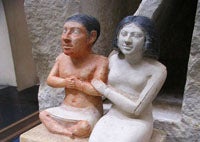In Egypt, Small People With Big Status
Posted in GUMC Stories
 Do not jeer at a blind man nor tease a dwarf,
Do not jeer at a blind man nor tease a dwarf,
Neither interfere with the condition of a cripple.
Do not taunt a man who is in the hand of God
Nor scowl at him if he errs.
So said the Egyptian wise pharaoh Amenhotep III some 3,500 years ago, reflecting the view in ancient Egypt that the care of the disabled is a divine honor. In fact, the most physically distinctive members of Egyptian society ⎯ the little people ⎯ were often the most celebrated.
It’s a viewpoint, based on compassion, that Chahira Kozma, M.D., wishes more people shared.
Individuals with dwarfism may be small in height (feet and inches), but they reached elevated positions within Egyptian society, says Kozma, a professor of pediatrics at Georgetown University Medical Center and chief of the division of genetics at MedStar Georgetown University Hospital.
 She has developed a passion for studying the physical evidence of achondroplasia ⎯ a bone growth disorder responsible for 70 percent of dwarfism⎯ in the 3,000 years leading up to the death of Cleopatra. “This is one of the most documented conditions in ancient Egypt due to the hot dry climate, elaborate burial systems as well as plentiful documentation in written forms and artistic representations,” Kozma says.
She has developed a passion for studying the physical evidence of achondroplasia ⎯ a bone growth disorder responsible for 70 percent of dwarfism⎯ in the 3,000 years leading up to the death of Cleopatra. “This is one of the most documented conditions in ancient Egypt due to the hot dry climate, elaborate burial systems as well as plentiful documentation in written forms and artistic representations,” Kozma says.
In ancient Egypt, people with large heads relative to their small bodies held positions of seniority, and were granted many titles and positions. Pharaohs wanted dwarfs in their households and Egyptians believed they were lucky and could protect the living as well as the dead from danger.
The little people were so highly valued that two Egyptian gods were dwarfs ⎯ Ptah, a creator god and the master architect of the universe, and Bes, the god of music and warfare. In Egyptian mythology, dwarfs were also associated with Ra, the sun god that created all life forms.
The long life of a genetic mutation
Kozma’s passion for the dwarfs of ancient Egypt began in 1982 during a stroll through the Louvre museum in Paris. “I was going through the Ancient Egyptian Collection and walking from one display to another when I came across a statue of the dwarf god Bes,” she says.
She is familiar with dwarfism. As a developmental pediatrician and a clinical geneticist, Kozma occasionally treats children born with achondroplasia in her practice. She also helps guide affected adults seeking genetic counseling to specialized care centers.
At the Louvre, Kozma immediately saw the potential of a depiction of dwarfism as part of a discourse with medical students, residents, and other health professionals. She started acquiring books and articles about dwarfism in ancient Egypt, as well as photos of statutes of Egyptian dwarfs.
Genetically, dwarfism represents the long life of a mutation that most often occurs spontaneously, usually associated with a father of normal height but of advanced age. Achondroplasia occurs in one in every 15,000-40,000 births.
Morally, a dwarf god serves to remind those same health professionals of just how an attitude of grace and even reverence can change, Kozma says.
A well-regarded deformity
Kozma actively started researching and writing about ancient little people. From 2006 to 2011, she published four articles in the American Journal of Medical Genetics, one as part of a collaborative team, and three as a single author.
In these series of articles, which has received national and international attention, Kozma maintains that achondroplasia was not depicted as an unsightly physical handicap, but a deformity that was viewed favorably, and associated with ritualistic and religious significance.
It is a topic that draws a lot of interest. Kozma talks about the dwarfs of ancient Egypt in genetics conferences, and at meetings of the American Research Council in Egypt, and Little People of America.
In her last piece, she and her Egyptian colleagues describe the skeleton of a dwarf mom who was found with a baby in situ. “She most likely died during delivery because her pelvis was too small and needed a cesarean section which was not available five thousand years ago,” Kozma says. “I was fascinated with her, and convinced the Egyptian team to disseminate their findings in an American scientific journal because I wanted to tell the world about how she most likely died during delivery ⎯ the story of a mother’s ultimate sacrifice.”
Kozma focuses on the positive and delights in “how this great ancient civilization handled individuals with disabilities.” She says that societal attitude of acceptance and even reverence seemed to have died with Cleopatra, and despite efforts to legislate fair treatment (the 1990 Americans with Disabilities Act), Kozma says many little people in this country still encounter discrimination in employment, marriage, and education.
“Hopefully with education, our societal attitude toward short stature is slowly improving,” Kozma says. “It may not reach that of ancient Egypt ⎯ but a little goes a long way.”
By Renee Twombly, GUMC Communications
(Published April 25, 2012)
